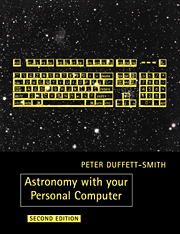Book contents
- Frontmatter
- Contents
- Preface
- Using your personal computer for astronomy
- DEFAULT: default value input routnine & YESNO: ‘Y’ or ‘N’ input routine
- MINSEC: converts between decimal hours/degrees and minutes/seconds form
- JULDAY: calendar date to Julian day number since 1900 January 0.5
- CALDAY: Julian day number since 1900 January 0.5 to calendar date
- TIME: converts between local civil and sidereal times
- EQHOR: converts between equatorial and horizon coordinates
- HRANG: converts between right ascension and hour angle
- OBLIQ: calculates the value of the obliquity of the ecliptic
- NUTAT: finds corrections for nutation in longitude and obliquity
- EQECL: converts between equatorial and ecliptic coordinates
- EQGAL: converts between equatorial and galactic coordinates
- GENCON: converts between any of the coordinate systems
- PRCESS1: approximate precession of equatorial coordinates & PRCESS2: rigorous precession of equatorial coordinates
- PARALLX: converts between geocentric and apparent position
- REFRACT: calculates the effect of atmospheric refraction
- RISET: finds the circumstances of rising and setting
- ANOMALY: solves Kepler's equation for elliptical motion
- SUN: finds the ecliptic coordinates of the Sun
- SUNRS: finds the circumstances of sunrise and sunset
- PELMENT: returns the orbital elements of the major planets
- PLANS: finds the position of a planet
- MOON: finds the position and parallax of the Moon
- MOONRS: finds the circumstances of moonrise and moonset
- MOONNF: finds the times of new and full moon
- ECLIPSE: finds the circumstances of lunar and solar eclipses
- DISPLAY: displays an eclipse in graphical form
- ELOSC: finds positions from osculating elliptical elements
- RELEM: converts elliptic orbital elements from one epoch to another
- PCOMET: finds the position of a comet from parabolic elements
- PFIT: finds parabolic elements from observations & EFIT: finds elliptical elements from observations
- List of variables
- Bibliography
- Index
- PROGRAMS AVAILABLE ON DISK
DEFAULT: default value input routnine & YESNO: ‘Y’ or ‘N’ input routine
Published online by Cambridge University Press: 17 February 2010
- Frontmatter
- Contents
- Preface
- Using your personal computer for astronomy
- DEFAULT: default value input routnine & YESNO: ‘Y’ or ‘N’ input routine
- MINSEC: converts between decimal hours/degrees and minutes/seconds form
- JULDAY: calendar date to Julian day number since 1900 January 0.5
- CALDAY: Julian day number since 1900 January 0.5 to calendar date
- TIME: converts between local civil and sidereal times
- EQHOR: converts between equatorial and horizon coordinates
- HRANG: converts between right ascension and hour angle
- OBLIQ: calculates the value of the obliquity of the ecliptic
- NUTAT: finds corrections for nutation in longitude and obliquity
- EQECL: converts between equatorial and ecliptic coordinates
- EQGAL: converts between equatorial and galactic coordinates
- GENCON: converts between any of the coordinate systems
- PRCESS1: approximate precession of equatorial coordinates & PRCESS2: rigorous precession of equatorial coordinates
- PARALLX: converts between geocentric and apparent position
- REFRACT: calculates the effect of atmospheric refraction
- RISET: finds the circumstances of rising and setting
- ANOMALY: solves Kepler's equation for elliptical motion
- SUN: finds the ecliptic coordinates of the Sun
- SUNRS: finds the circumstances of sunrise and sunset
- PELMENT: returns the orbital elements of the major planets
- PLANS: finds the position of a planet
- MOON: finds the position and parallax of the Moon
- MOONRS: finds the circumstances of moonrise and moonset
- MOONNF: finds the times of new and full moon
- ECLIPSE: finds the circumstances of lunar and solar eclipses
- DISPLAY: displays an eclipse in graphical form
- ELOSC: finds positions from osculating elliptical elements
- RELEM: converts elliptic orbital elements from one epoch to another
- PCOMET: finds the position of a comet from parabolic elements
- PFIT: finds parabolic elements from observations & EFIT: finds elliptical elements from observations
- List of variables
- Bibliography
- Index
- PROGRAMS AVAILABLE ON DISK
Summary
DEFAULT
The handling programs in this book, whose names all begin with the letter H (e.g. HEQECL, HALTAZ, etc.) require the user to supply answers to questions such as ‘Today's date?’ or ‘Geographical latitude?’. Often it is convenient to make use of default settings for the answers, especially if they are many characters in length. Routine DEFAULT allows you to do this very simply. To use it, you supply the question in the string variable Q$, the number of variables to be entered in N (= 1, 2, or 3) and the default settings for those variables in X, Y, and Z. The routine then displays the question on the screen together with the default settings in square brackets [], and waits for a response. You may enter new numbers for the variables as usual if you wish. Alternatively, you can enter a comma (,) in place of every variable, and the routine uses the default values instead. The new values, or default settings, are returned in the same variables X, Y, and Z.
Routine DEFAULT is used later in the book in the handling programs HELOSC, HPCOMET, HPFIT, and HEFIT. In HELOSC, for example, lines 160 and 165 get the date of the epoch (D,M,Y) by setting Q$=“Epoch (D,M,Y)”, X, Y, and Z to the default values of the day, month, and year respectively, and N=3 (since there are three variables to assign). Suppose that X, Y, and Z were given the default values 12, 3, 1986 respectively.
- Type
- Chapter
- Information
- Astronomy with your Personal Computer , pp. 7 - 9Publisher: Cambridge University PressPrint publication year: 1990



